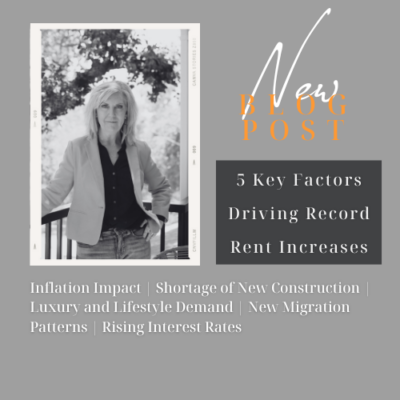 5 Key Factors Driving Record Rent Increases
5 Key Factors Driving Record Rent Increases
Rising rents in the U.S. multifamily market have surged by 14.8% over the past year, fueled by a combination of factors that have created a perfect storm of rent growth. This explosive price growth trend, which began in 2021, is being driven by multiple influences:
- Inflation Impact: Inflation has soared, pushing up the Consumer Price Index by 7.9% year-over-year, the highest in 40 years. This has significantly increased the costs of building rental properties, driven by surging commodity prices and supply chain disruptions due to COVID-19. The elevated construction materials, labor, and oil costs have cascaded into higher development expenses, ultimately raising rental prices.
- Shortage of New Construction: The demand for new apartments is strong, but a new construction shortage poses challenges. The multifamily industry needs to build around 328,000 new apartments each year to meet demand, yet construction timelines are lengthening due to various factors, including supply chain disruptions, labor shortages, and delays related to the COVID-19 pandemic. This shortage of new supply puts upward pressure on rents.
- Luxury and Lifestyle Demand: Despite rising rents, demand for luxury and lifestyle apartments remains robust. A segment of renters, characterized by higher incomes and lifestyle preferences, is willing to pay higher rents for the amenities and quality these apartments offer. Additionally, the rising cost of single-family homes is redirecting potential buyers toward rental housing, increasing demand and further driving rent growth.
- New Migration Patterns: The COVID-19 pandemic has led to shifts in housing demand due to remote work and lifestyle changes. Many Americans are moving to areas with better living conditions, resulting in a mismatch between demand and available housing supply in certain markets. This imbalance has driven prices upward in regions experiencing population influxes, contributing to higher rents.
- Rising Interest Rates: With the Federal Reserve tightening its monetary policy, mortgage interest rates have been on the rise. This can impact the decision to buy a home versus renting, increasing demand for rental housing. Developers face higher financing costs, exacerbating supply challenges caused by other factors like supply chain disruptions and construction delays.
Addressing the Issue of Rising Rents
To address the issue of rising rents and housing affordability, it’s important to consider multifaceted solutions. While government funding through bonds may seem like a solution, it can inadvertently lead to higher costs being passed on to renters. Instead, a balanced approach should be considered:
1. Increase Housing Supply: Encourage and streamline the construction of new housing units to meet growing demand. This can involve zoning reforms, expedited permitting processes, and incentives for developers to build affordable units.
2. Support Affordable Housing: Invest in affordable housing production to cater to low- and middle-income renters. This can involve partnerships with developers, nonprofits, and community organizations to create more affordable rental options.
3. Address Regulatory Barriers: Streamline regulations that contribute to delays and increased construction costs. Simplifying the permitting process and reducing unnecessary regulations can expedite new housing development.
4. Promote Mixed-Use Developments: Encourage the creation of mixed-use developments that combine residential and commercial spaces, promoting walkability and reducing the need for long commutes.
By adopting a comprehensive approach that considers these factors, communities can work towards addressing the challenge of rising rents while maintaining housing affordability and choice for renters.

